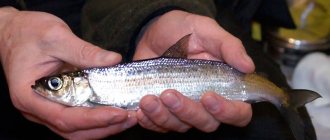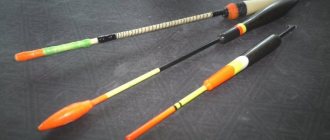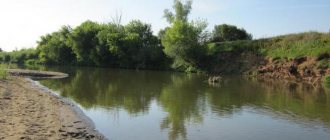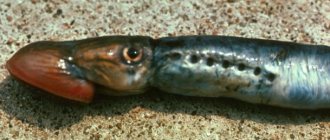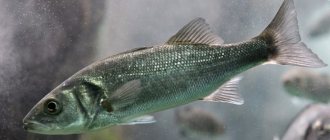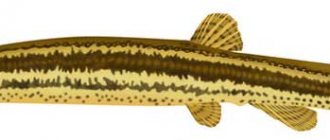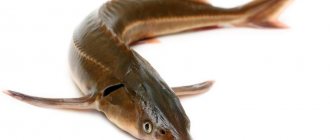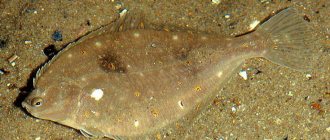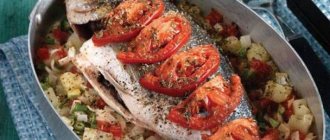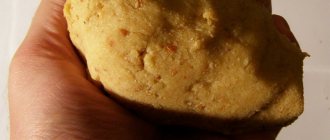There are several versions of why cod fish is called that way. The first is that in winter they brought it frozen from Arkhangelsk, and when the fish was unloaded from the sleigh, it crackled. But this is just a legend.
What tastes better?
- Tilapia 86%, 38 votes
38 votes 86%38 votes - 86% of all votes
- Pangasius 14%, 6 votes
6 votes 14%
6 votes - 14% of all votes
Total votes: 44
16.01.2020
×
You or from your IP have already voted.
The second story, more plausible, is related to the fact that her swim bladder contracts, making sounds. Therefore, something like thunder or crackling is heard from schools passing in the water.
What kind of fish is cod and where does it live?
Description
All codfish have characteristic, similar external features that distinguish them from other marine life. They have a classic spindle-shaped body, almost always have 2-3 fins on the back, two gill fins and two anal fins.
Cod fish do not have sharp, spiny bones on their fins. Almost all specimens have an unpaired long or short antennae growing on the chin. Fish scales are round, small, and easy to clean, so their bodies are covered with protective mucus.
Characteristic
Cod fish need fairly icy water from 1 to 10° Celsius, so representatives of the family can be found in almost all sea waters of the northern World Ocean. However, Northern European, Asian and North American rivers and lakes are preferable for burbot.
The largest number of cod are found in the Barents, Bering, Norwegian, White, Japanese, and Okhotsk seas, that is, in the Eastern Atlantic, Arctic and Pacific Oceans. The Baltic Sea is habitat only for Baltic cod, and the coast of Greenland is habitat for Greenland cod. Some species of cod also live in the Black and Mediterranean Seas.
Several species of this family are also found off the South African, South American, and New Zealand coasts.
Predator or not
Cod fish are predators or carnivores. But they become such only by adulthood, that is, by 3-4 years. Until this time, the young swim in the bottom space and eat microplankton and small crustaceans.
Just as shellfish are a source of food for cod, so young cod serve as a diet for shellfish.
What does cod eat?
What does cod eat? Her favorite delicacy is live fish. She chooses food depending on the seasons. Thus, in winter the food consists of small herring, in spring - cod, capelin, and in summer crustaceans and sedentary elasmobranch mollusks, which are numerous at this time of year, are added to its diet.
Ice cod, blue whiting, and polar cod eat only zooplankton.
Cod fish often have cases of anthropophagy - eating smaller fish of their own or another species.
Nutritional Features
All members of the cod family are predators. Red cod up to 3 years of age feeds on small crustaceans and plankton. Then, when the size increases, the cod diet is replenished with meat from other types of fish. The predator feeds on sprat, smelt, herring, saury, capelin, and cod. In addition, this underwater inhabitant is characterized by cannibalism: adult individuals devour young animals. The diet also includes invertebrates living on the ocean floor.
The menu of the Pacific variety includes worms and shellfish. It also feeds on pollock and navaga.
Character and lifestyle
Cod fish usually move in compact schools. The single freshwater burbot is the only exception of its kind.
Habitats directly affect the lifestyle of cod. Thus, Pacific cod practically does not migrate, and the Atlantic species (the largest cod) moves up to one and a half kilometers back and forth in one season to spawn.
Cod drifts in deep cold waters, but when chasing prey, it rises to the upper layers of water. Not being essentially a schooling fish, it gathers in large schools during spawning or in places where large amounts of food accumulate.
Reproduction and lifespan
It has been established that some species of cod feed in one place and spawn in another. Other species go to breed in desalinated water bodies.
Cod are one of the most fertile fish species, and they begin to lay eggs only when a certain amount of fat has accumulated in the liver. But this happens only 3-4 times in a lifetime.
Different members of the family carry eggs in different ways. The Atlantic cod species spawns on the Norwegian Lofoten Islands only from 8-9 years of age. Representatives of Pacific cod reproduce from the age of 5-6 years. Arctic and Kildin cod breed at the age of 4 to 5 years, and pollock is ready to spawn at 3-4 years.
An adult female spawns approximately 8 to 10 million eggs in one mating season. Their spawning period begins in early spring. Adult males and females gather together at this time. The eggs are spawned at a depth of approximately 100 meters in measured doses, even for a long time until June. At the same time, male cod fish swim nearby and inseminate the emerging eggs. The eggs sink deeper and attach to the vegetation growing at the bottom.
Having spawned, the fish also return in races to their feeding grounds; on the twentieth day, fry emerge from the eggs and are carried by currents throughout the ocean. For the first 2-3 years of life, their habitat is the bottom, where they eat small crustaceans and plankton.
The lifespan of cod is from 30 to 35 years, and during this time its length can reach almost 2 meters (it grows almost all its life). In industrial fishing, five-year-old fish up to 80 cm long and weighing up to 5 kg are caught.
Norwegians know a lot about cod!
And it is understandable - this is the most common fish in the fjords! So it would be wise to take advantage of their experience. They have their own idea of what red cod is; the recipes are suitable for any variety of it. For example, there is an absolutely simple, but very refined and pleasant dish. For one fish carcass you will need a bottle of unfortified red wine, an onion or two, seasonings and breadcrumbs. The washed and gutted cod is cut into portions, the fins with the head are either left on the ear or donated to the cat. Onions are laid out in a deep bowl (as always, in half rings), on top - fish, which is then salted, peppered and supplied with other seasonings, if you have provided them, after which the container is filled with wine. After eight hours, when the pieces are marinated, they are removed from the marinade, rolled in breadcrumbs and fried. The remaining marinade is strained and boiled down by about three times. If you need it, dilute it with some water (if salty) or, on the contrary, add what is missing. Pour this sauce over the finished fish - you can't imagine anything better.
Types of cod
Codfish are grouped into 4 subfamilies:
Sea burbot:
- sea burbot,
- uroficis - ficin hake;
- hydropsarine:
- sea burbot (hydropsarus);
- Ciliata,
- Enchelyopus,
- Lotinae:
- Menek - Menek,
- Burbot - Burbot.
Rumors:
- Birkelang,
- Big-eyed prayer,
- Word of mouth.
Gadinae:
- Whiting.
Sides:
- Lur,
- Saida.
Haddock:
- Haddock.
Cod:
- Atlantic cod,
- Kildinskaya,
- Baltic,
- Belomorskaya, abroad it is an analogue of Greenland cod,
- Pacific cod,
- Greenland cod,
- Pollock.
Navagi:
- Far Eastern navaga,
- Northern navaga (navaga).
Arctic cod:
- East Siberian cod,
- Arctic (ice) cod.
Saiki: Saika.
Pollock:
- Far Eastern pollock,
- Atlantic pollock.
Blue whiting:
- Northern whiting,
- Southern whiting.
Tomcodes:
- Pacific Tomcode,
- Atlantic Tomcode.
Gadicles: Deep-sea viper):
- Northern viper,
- Southern viper.
Chaplains:
- Mediterranean Chaplain,
- Esmark codfish,
- French cod,
- Ordinary chaplain.
Gadikul
The big-eyed cod or gadikul is the deepest (lives up to 1 km, often at a depth of 200 to 600 m) and is the smallest of the cod: the length of adult fish is only 9-13 centimeters, extremely rarely 15 centimeters. It has very large eyes. The fleshy baleen is missing.
Its habitat is the Adriatic Sea, the eastern part of the Mediterranean Sea to the Faroe Islands of the Kingdom of Denmark and to Northern Norway. Therefore, there are 2 types - the northern viper and the southern viper.
The fish are organized in large schools, drifting near the bottom, feeding on small krill and worms.
Whiting
Whiting looks almost like haddock, which is why they are constantly confused. The scales of the fish are brownish-brown, silvery on the sides, whitish on the belly. There are three dorsal fins, the last of which becomes an unforked caudal fin.

The length of the cod reaches 45 cm.
Whiting lives along the entire coastline, stretching from Portugal to Iceland and in the Barents Sea. But it is also found in continental seas: the Black, Adriatic, Aegean.
The fish is predatory, its menu includes smaller fish, squid, cuttlefish, bivalves - mussels, oysters, shrimp, crab, worms.
Pollock
Pollock has larger eyes than other cod and a very short, almost invisible barbel on its chin. Its pectoral fins are located behind the pelvic fins.
These fish are cold-loving and therefore live at a depth of 200 or 300 meters, but for prey they move further inland from 500 to 700 meters. Females of the genus spawn even at sub-zero water temperatures. It lives in the northern seas of the Pacific Ocean, and the Atlantic pollock, a closely related species, lives in the Barents Sea.
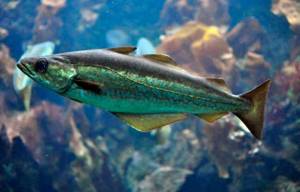
Adult pollock preys on capelin, squid, smelt, flounder, and also eats its own and others' larvae and fry.
Word of mouth
Sea pike (molva, ling) is the largest fish in this family. It can grow up to 2 m in length and weigh up to 40 kg. And it was called pike because of its long head, similar to the head of a freshwater pike. Has long dorsal and anal fins.
This sea cod drifts along the entire coast of the eastern Atlantic from Scandinavia to the Cantabrian Sea, in the North Sea, in the Skagerrak. Sometimes schools of moth are caught by recreational fishermen in the Mediterranean Sea.
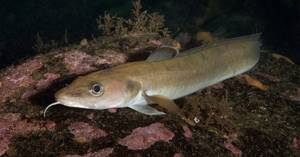
Pike fish are ferocious predators, eating live herring, other codfish, flounder, molluscs, crayfish and starfish.
Use in cooking
It so happens that cod is a product that is used in almost any national cuisine. This type of fish is widely known throughout the world and is present on tables in every country. You can cook anything from cod and its liver, from soups to appetizers. Cod carcass can become an independent dish that can be easily and quickly prepared in the oven. But the most popular method is drying, drying, salting and smoking fish. This is because cod is one of the few types of fish that, when dried and salted, retains all its beneficial properties.
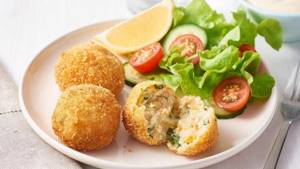
Far Eastern navaga
Pacific navaga or vakhnya, as well as Far Eastern navaga - all this is the name of one of the representatives of the genus navaga.
It is found in the northern seas of the Pacific Ocean (Chukchi, Bering, Okhotsk, and Japan seas); like smelt, it is caught by amateur fishermen in the Primorsky Territory of Russia on established winter ice. It practically does not swim in open waters, as it is a coastal fish. In the autumn-winter season, schools of wahni enter fresh water.
The length of the average navaga is about 30 centimeters, weight – 250 grams, but there are also specimens up to 50 centimeters long and weighing up to 1 kilogram.
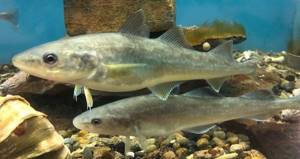
Navaga is a predator, like most cod. It feeds on larvae and juveniles of other fish, higher crayfish (crab, woodlice, amphipod), and worms.
Northern navaga
This navaga also loves the cold and is found in the seas of the Arctic Ocean (Pechora, White Seas, Ob Bay). It is coastal and lives at shallow depths, but during the spawning season it gathers in large schools and moves to rivers and lakes with the tides.
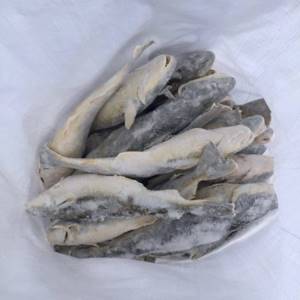
The navaga reaches 30-35 cm in length; specimens 40-42 cm in length were caught in the Kara Sea, and the size of the White Sea navaga is from 15 to 23 cm. The main food of the predator is amphipods, worms, mysids, and young fish.
Burbot
The common or smaller burbot does not form schools; it is a solitary fish and the only one of the family that inhabits fresh waters.
The burbot's body is long, covered with mucus and small scales, and its head is flattened like a frog's, making it impossible to confuse it with any other fish.
Burbot, like its marine relatives, is a predatory fish. It feeds on young fish, larvae, worms, crayfish and frogs.
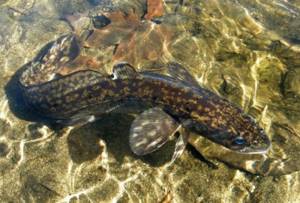
It is found in any reservoir where there is running water and a rocky or clay bottom.
In northern Siberian rivers you can catch burbot weighing up to 32 kilograms and measuring up to 2 meters in size. Specimens living in more southern rivers are smaller in size.
What are the benefits of sea fish?
It is worth noting that fish, like different types of meat, is more healthy or satisfying, and there is neutral in relation to health or completely dietary. So, although river fish has a high content of phosphorus and calcium (very necessary elements!), it is not known for any other useful properties. While the inhabitants of salt waters are sources of extremely necessary Omega-3 acids, which are needed for the smooth functioning of the heart, the strength of blood vessels, stable brain function and getting rid of bad cholesterol. In addition to this, any (including the so-called red) cod contains tryptophan, which can be converted into serotonin - a “good mood” substance. And the sulfur that this fish contains also improves the condition of nails and hair. Plus, the tenderness, low-fat and anti-allergenic nature of cod meat - all this makes it an ideal component of baby food.
Haddock
The habitat of haddock is the salty cold waters of the seas belonging to the Atlantic and Arctic oceans: the Norwegian, Barents Seas, the coast of Iceland.
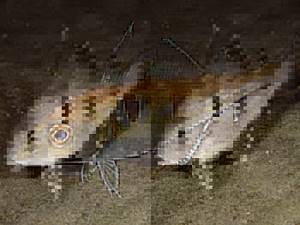
This is a large sea cod, growing more than half a meter in length and weighing about 3 kilograms. Rarely are larger individuals more than 1 meter long and weighing about 15 kilograms. The body of the haddock is flattened on the sides, the fins are black.
Types of fish
Atlantic cod is a large fish. Her body weight can reach 95 kg. The belly of the fish is usually white, and its back has a brown or greenish tint.
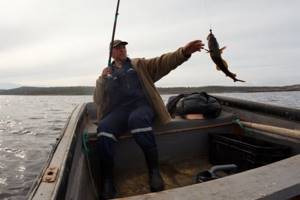
This type of cod is found in the waters of the Baltic Sea and Greenland. Pacific cod is smaller in size than Atlantic cod. Its weight does not exceed 23 kilograms, and its body length is approximately 120 cm.

Externally, it is very similar to Atlantic cod. The habitat of this species of cod is the Pacific Ocean and the Sea of Okhotsk. Greenland cod lives in the waters of Greenland. Its body length reaches approximately 75 cm.
Northern and southern blue whiting
Northern whiting is distributed in the northeastern and northwestern parts of the Atlantic Ocean: Spitsbergen, Iceland, the western part of the Barents Sea, Nova Scotia, the Great Newfoundland Bank, southern Greenland.
The southern one is found in the southwest Atlantic on the widely developed Patagonian shelf, in the Pacific Ocean southeast of New Zealand.
Northern whiting grows from 18 to 30 cm, less often up to 47 cm. These are fairly small schooling fish, they live at depths from 30 to 800 m. Southern whiting is much larger and can grow up to 60 cm and up to 1.5 kg.
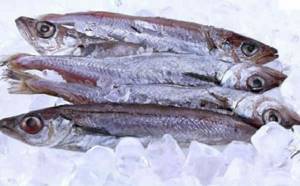
The basis of the diet of both species of whiting is plankton, juvenile luminous anchovies, cod, herring and others. In turn, whiting themselves provide food for other cod and mammals (pilot whales, dolphins).
Arctic cod. Features of the species.
ATLANTIC COD (Gadus morhua)
ATLANTIC COD (Gadus morhua) is the most numerous species of the family, with the widest range, covering the boreal (temperate) region of the Atlantic and Pacific oceans, forms several subspecies and a significant number of races.
Description: It has three dorsal and two anal fins, a large head with a large terminal mouth. The antenna is well developed. Color varies greatly; The color of the back is green or yellowish-brown, sometimes brown, with numerous small yellowish-brown spots. The sides are the same tone, lighter, the belly is yellowish or white. The lateral line is light, clearly visible throughout the entire body, and forms a slight bend above the pectoral fin.
Habitat: In the Atlantic Ocean, cod is distributed from Cape Cod and the Bay of Biscay to Greenland, Spitsbergen and Novaya Zemlya. In the Pacific Ocean, cod is known from the Bering Strait to California and Korea. Cod is a euryphage, using all types of food from plankton to relatively large fish. The most numerous is the Atlantic cod (Gadus morhua morhua), containing several races (stocks), the life cycle of which is tied to the current systems of the North Atlantic Ocean and adjacent areas of the Arctic Ocean.
Spawning places: The main races are: the Norwegian-Barents Sea, or Arctic, breeding off the coast of Norway from Mere to the Northern Lofoten Islands and fattening in the Barents Sea and in the Bear-Spitsbergen shallow waters; Icelandic-Greenlandic, associated with the Irminger Current, breeding off the southern and southwestern coasts of Iceland and migrating to the northern shores of the island and to Greenland; Lab-Rador-Newfoundland, associated with the circulation of warm Atlantic waters penetrating into Davis Strait, breeding in Northern Labrador, from where the juveniles drift to the northwestern slopes of the Newfoundland shallow waters; Newfoundland, living along the frontal zone of shelf and slope waters and the Gulf Stream from Cape Cod to the western slope of the Newfoundland Bank.
The most widespread and powerful is the Norwegian-Barents-Sea race .
Description: Its individuals reach the largest sizes: the usual size is 40-80 cm, but can reach 150-180 cm in length and over 40 kg in weight.
The main spawning grounds of this race are in the Westfjord, off the Lofoten Islands, Northwestern Norway, which is why it is often called Lofoten. Spawning occurs in March - April at a depth of up to 100 m, on the border of warm underlying waters of Atlantic origin and local, colder and somewhat desalinated fiord waters. Swept and fertilized pelagic eggs are picked up by the current. The eggs carried by the current and the larvae that hatch from them swim up to 200 km. The first days the larvae feed from the yolk bladder, and then switch to active external feeding on small forms of plankton. In accordance with the direction of the currents, some of the juveniles end up on Bear Island, but a large number of them are brought into the Barents Sea with the North Cape Current. All this time, the juveniles live in the water column and feed on planktonic crustaceans—kalyanus. By July, fry 3-4 cm long, drifting north, reach 72-73° N. sh., and drifting to the east - the Kola meridian (33° E). In September, juvenile cod reach the eastern regions of the Barents Sea, where they switch to a bottom lifestyle. Repeatedly, young cod were found in the Spitsbergen Current beyond 80° N. sh., i.e. already in the Arctic Ocean basin. Their fate is unclear. Perhaps they die, but it is possible that they end up in the Barents Sea with waters penetrating between Spitsbergen and Franz Josef Land. In the first two years of life, juvenile cod are inactive and are not able to return to warmer waters. Yes, she doesn’t strive for this. Young cod tolerate temperatures of 1°C and below, actively feeding on small crustaceans at this time. From the age of three, cod begins to make noticeable migrations in the summer along the current to the north and east, and in the winter against the current to the south and west. With age, the migration range of cod expands to cover the eastern regions of the Barents Sea. From this time on, cod becomes a predator, and its growth increases sharply. Three-year-old fish weigh 300-350 g, four-year-old fish weigh 600-700 g, and five-year-old fish weigh 1000-1200 g. The Barents Sea cod feeds mainly on three numerous species of planktivorous fish - herring (mainly juveniles), capelin and, in some areas, cod. In relatively warm years, herring, which winters in the near-bottom horizon, becomes important in the food of cod, especially in winter. In spring, cod always feeds on capelin, which it encounters in open areas of the sea on its way to the last of the northern regions and accompanies schools of which to spawning grounds off the coast of Murman or Northern Norway. In cold years, when the range of the cod expands and the number of cod increases, cod finds large concentrations of it in the east. In addition, in the summer, cod often feeds on blackeyes, crustaceans from the Euphausiaceae family, which form dense aggregations in the central regions of the sea. Sometimes it also uses bottom fauna, mainly bivalves, from which it bites off the legs they extend. Cod also feed on their own young, and large individuals, weighing several kilograms, most often feed on their smaller counterparts. In cod weighing several kilograms you can sometimes find cod weighing a kilogram, and in the latter - dozens of fingerlings or yearlings of cod. At eight to ten years old, weighing 3-4 kg, Barents Sea cod begins to prepare to continue its genus. In the last summer, she visits the far eastern or northern areas of the sea, especially rich in food. She finishes her fattening in September - October, gathers in large flocks in areas under the influence of the warm North Cape Current, and begins her migration to the Lofoten Islands. She completes this journey, over 1,500 km long, in 5 months at an average speed of 7-8 km per day. Along the way, cod rests in places and sometimes feeds, but it can make this journey using fat reserves accumulated in the liver - the main fat depot of cod fish, which ensures migration and development of the gonads. In the movement of cod to spawn, the main landmark is the North Cape Current, with the waters of which young cod penetrate into the Barents Sea. The arrival of schools of cod to spawn in the Lofoten Islands is a big event in the life of the population of Northern Norway, who gather at their doorstep a rich harvest grown in the vastness of the Arctic Ocean. The entire population takes part in this fishery; thousands of small motor boats with simple weapons in the form of hand fishing rods, longlines and nets rush to schools of cod at a common signal for all. There are so many people who want to catch cod that all the bots are divided into two groups, one of which takes turns catching especially powerful aggregations, and the other uses secondary aggregations that day. From Saturday to Monday, cod fishing stops completely. For fishermen, the long-awaited rest and time to repair fishing gear comes; cod is given the opportunity to fulfill the duty of reproducing its offspring. Each female lays 2-3 and even 4 portions of eggs, this forces her to stay on the spawning grounds for several weeks; Males, who participate in the fertilization of many females, stay on the spawning grounds for just as long, and sometimes even longer. It is not surprising, therefore, that the intensity of fishing on spawning grounds is very high and out of every two fish that come to the spawning grounds, one is taken by the fishery, and in some years, out of three fish that come, two are caught. Spawned individuals rush to feeding areas to replenish lost strength, fatten up, and a year later reappear on spawning grounds to continue the race. Cod can live up to 20-25 years. Far in the open sea over great depths it is rarely found, although there is enough food there in the form of fattening Atlantic-Scandinavian herring. The Icelandic-Greenland cod in its biology resembles the Norwegian-Barents Sea cod; it also makes long migrations and has a large feeding area and a small spawning area. Northwestern Atlantic (Labrador-New Foundland) cod forms local stocks; drift of juveniles by currents and active migrations are of less importance in their life. The biology of individual races in this area has not been sufficiently studied. The migratory cycle of cod that breeds off Northern Labrador and makes feeding migrations to the northern slopes of the Newfoundland shallows emerges more clearly than others. Special subspecies of cod live in the Baltic and White Seas. They have adapted to life in these desalinated seas, do not make long migrations, and mature earlier than Atlantic cod, in the 3-4th year of life. The sizes of their individuals are smaller, especially in the White Sea. Baltic cod (Gad us morhua callarias) is one of the most important commercial fish in the Baltic Sea. It reaches a length of over 100 cm and a weight of 11 kg. It matures in the third year of life, upon reaching a length of 20-27 cm, and lives up to 10 years. The main food of juvenile cod in the first or second year of life is crustaceans and polychaetes. As fish grow, crustaceans are replaced by fish, and herring and sprat become the main food of cod. Cod spawning occurs in the western part of the sea in winter-autumn, in the areas of the Baltic Sea depressions at a depth of 80-100 m at a salinity of 12-18%0 and a temperature of 4-5° C. White Sea cod (Gadus morhua marisalbi) lives in saline areas White Sea, not found in the highly desalinated Dvina and Mezen bays and in the southern part of Onega. It grows much more slowly, reaches a smaller size and is younger than Atlantic cod. Its maximum length is 58-60 cm, and its age is 11 years. Commercial catches are dominated by cod aged 3-5 years, 25-35 cm in length. White Sea cod spawns under ice, at a temperature of -0.5-1.0° C. Two lake forms of cod are also known. In Lake Mogilny on the island of Kildin and in Lake Ogak at the top of Frobishera Bay on Baffin Island, cod lives in the middle layers of water, penetrating into these lakes at a time when they were still connected to the sea, whereas now they are separated by pebbly and sand oversprinkles. Now the top five-meter layer of water in these lakes is fresh, and the bottom layers are poisoned by hydrogen sulfide, and cod can only live in the middle layers that retain sea salt water. In these conditions, “between a rock and a hard place,” cod lives, reaching the usual length for this species of 60-80 cm. It is numerous in Lake Ogak, and the local residents, the Eskimos, hunt for it.
Saida
This representative of cod is not a bottom-dwelling fish.
The maximum length of cod is up to 130 cm, weight up to 32 kg. A light stripe clearly appears on the body, running from head to tail parallel to the back.
It is found practically at a depth of up to 250 m and on the coast of the entire north Atlantic Ocean, in the North and Baltic seas.
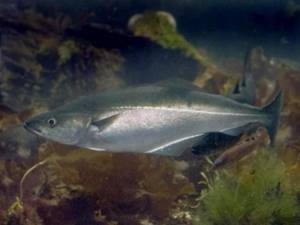
Young pollock fish eat mainly crustaceans and fish larvae, while adults eat small schooling fish (herring, sprats).
Fishing for red cod
Catching red cod is an exciting activity, but not even every professional with many years of experience knows where and how to properly catch a predator.
Where to fish?
On the territory of the Russian Federation, most of the fisheries occur on the territory of the Kola Peninsula and the White Sea. Most often it is located along the coastal zone. Most fishermen go to the northern parts of the country to catch the coveted predator.
When to catch?
The fish loves cool waters, so it is best to hunt for them in the cold season. Fishing is notable for the fact that you can catch both a three-kilogram specimen and a real trophy weighing 20 kg.
What to catch?
Most often, cod is found at a fairly large depth of tens of meters. So, for example, in a water column of 30-40 meters, living conditions are absolutely acceptable for it. It is important to note that cod is a predatory fish that, during active migration, loves capelin, herring, and sprat.
Good to know! Therefore, meat bait will become a relevant choice. As a rule, it approaches Russian territories for active herring hunting. This is a schooling fish, so if you use the right tactics, you can catch a great catch.
Atlantic
Description
The life of this cod is closely connected with the currents of the North Atlantic and Arctic oceans. Every year, races (stocks) of fish drift over distances of up to 1.5 thousand kilometers from spawning grounds to feeding grounds and back.
Races of fish are named after their spawning and feeding grounds. The Norwegian-Barents Sea herd raises its offspring off the coast of Norway and feeds in the Barents Sea. The Labrador-Newfoundland herd spawns on the coast of Labrador and then sails to Newfoundland to fatten.
Characteristic
During the first years of life, the fish are found only near the bottom. Their diet consists of a variety of small fish, and this cod is also no stranger to eating its own young. In summer, zooplankton and bivalves are added to the diet.
This largest cod grows up to 2 meters in length.

Kildinskaya
Kilda cod is listed in the Red Book. This is a very rare subspecies of the Atlantic species. The peculiarities of its reproduction are directly related to its location in Lake Mogilnoye (Kola district of the Murmansk region). Since the water in the lake is salty (except for the surface), this subspecies cannot be considered freshwater.
Its eggs are small and weigh little, so they do not fall to the bottom of the lake, but also do not float to the surface. The larvae develop in the middle layer suitable for them, and as they develop, they rise to the top, where there is more oxygen. The fry hatch and then descend back into the depths of the reservoir favorable for life.
Kilda cod eats small amphipods, representatives of the order of crayfish, woodlice, polychaetes, bell mosquitoes, small smelt and butterfish.
Pacific
Pacific cod does not drift far into the ocean; its migrations depend on the time of year and pass in winter from the shore deep into the water, and with the onset of warmth they return to the coast to their favorite feeding grounds. Its habitat is the North Pacific Ocean.
Pacific cod larvae hatch from eggs that grow attached to benthic fauna.
It looks like Atlantic cod, but its dimensions reach 120 cm and its weight is 22 kg.
Pacific cod in the sea is a predatory fish; it eats other types of fish, other cod, octopus, shrimp, crabs, and worms.
How to cook cod
Delicious dishes can be prepared from this fish. Very tasty and healthy cod caviar. Cod can be canned, pickled, fried, stewed, boiled, or salted. Delicious cod in the oven.
To do this, you need to wash the cod fillet well, salt and pepper it, and place it on a baking sheet. Separately, you need to mix equal portions of mayonnaise and sour cream. Add lemon juice and a little mustard to this sauce.
Pour this contents over the fish fillet and place in a hot oven for half an hour. The dish turns out tasty and healthy. They can not only diversify your menu, but also nourish the body with many useful microelements and substances that this fish is rich in.
Commercial cod fishing
Cod is an important fishery in the world and is a delicacy in a large number of European countries. Its advantage lies primarily in the liver, rich in Omega-3 fatty acids, which the human body cannot produce itself. Cod fish have lean, juicy and tasty white meat.
It is cod that are the best sources of proteins and many vitamins, so commercial fishing of this species has been ongoing for several centuries. Cod is trawled in the sea, caught with snares, longlines, nets and venters.
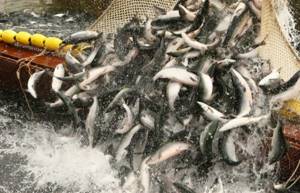
The world leaders in the extraction of biological resources are held by China, the USA, Indonesia, and Russia.
Pacific pollock, along with whiting, was not previously considered a valuable food resource. However, today it has become the leader in production volume among all cod fish. Pollock is caught with trawls and also with seines placed on it. In the Russian zone, the minimum commercial size for pollock is 20 centimeters.
Blue whiting began to be caught on an industrial scale in the 70s of the last century. But its use in the fishing industry in northern Europe and Russia has increased sharply in the last decade. Every year, up to 250 thousand tons of northern blue whiting are caught in the Norwegian Sea, and the total volume of its fishing exceeds 500 thousand tons. This puts it in 5th place among all fish in terms of commercial catch.
The Atlantic species is caught on trawlers all year round. Right on the ships, this fish is used to make fillets, cleared of bones, heads and entrails. However, according to scientists, the cod population as a result of industrial fishing has fallen sharply compared to the original stocks. Realizing the catastrophic consequences, governments introduced cod fishing quotas to allow the species to revive its numbers. But she did not fully recover. And according to the UN Food Organization, humanity has already caught 90% of marine reserves.
According to forecasts, in 30-40 years, if the rate of fishing continues, there may be no fish left in the sea.
Cod epic
There are not so many fish that have played such an important role in the lives of different peoples as cod; only herring can compete.
The beginning of man's use of cod is lost in the mists of time. Cod is the hero of ancient Scandinavian travel sagas; it is not without reason that Viking routes coincide with cod habitats. The ancient Scandinavians invented an interesting way of preparing fish in order to cross the ocean. They dried the fish plates in the cold in winter, and then the fish that had lost weight took them on ships and went on long voyages.
Cod also played a major role in the life of the northern peoples - the Pomors. In the years when the lands adjacent to the White Sea did not produce bread, fishing saved the northerners. The Pomors caught a variety of fish, but cod turned out to be truly universal. It could be on the table dried, dried, salted, or as part of fish soup.
Cod saved not only Pomors, British and American colonists, but also Canadians from starvation. The cod fishery in Canada was so large that by the end of the twentieth century there was a “cod crisis” and the population of this fish declined sharply. So the government even had to impose a moratorium on fishing.
Today, in order to avoid “overfishing” of fish and destruction of the population, various international associations and corporations are being created that set cod catch limits.
